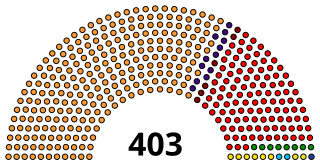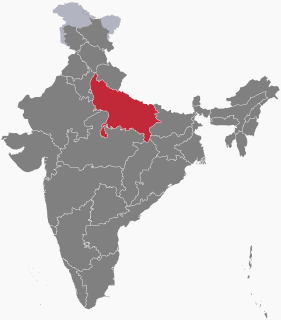
A Member of the Legislative Assembly (MLA) is a representative elected by the voters of an electoral district (constituency) to the legislature of State government in the Indian system of government. From each constituency, the people elect one representative who then becomes a member of the Legislative Assembly (MLA). Each state has between seven and nine MLAs for every Member of Parliament (MP) that it has in the Lok Sabha, the lower house of India's bicameral parliament. There are also members in three unicameral legislatures in Union Territories: the Delhi Legislative Assembly, Jammu and Kashmir Legislative Assembly and the Puducherry Legislative Assembly. Only a Member of the Legislative Assembly can work as a minister for more than 6 months. If a non-Member of the Legislative Assembly becomes a Chief Minister or a minister, he must become an MLA within 6 months to continue in the job. Only a Member of the Legislative Assembly can become a Speaker of the Legislature.

The Puducherry Legislative Assembly is the unicameral legislature of the Indian union territory (UT) of Puducherry, which comprises four districts: Puducherry, Karaikal, Mahé and Yanam. Out of eight union territories of India, only three have legislatures and they are Delhi, Puducherry and Jammu and Kashmir. After delimitation shortly after its formation, the Puducherry legislative assembly has 33 seats, of which 5 are reserved for candidates from scheduled castes and 3 members are nominated by the Government of India. 30 out of 33 Members are elected directly by the people on the basis of universal adult franchise and the remaining three are nominated by the central government. These nominated members enjoy same powers as elected members of the assembly.
In India, a number of political positions and university posts are held for specific groups of the population, including Scheduled Castes and Scheduled Tribes, and women in some cases.

The Uttar Pradesh Legislative Council is the upper house of the bicameral legislature of Uttar Pradesh, a state in India. Uttar Pradesh is one of the six states in India, where the state legislature is bicameral, comprising two houses: the Vidhan Sabha and the Vidhan Parishad. The Vidhan Parishad is a permanent House, consisting of 100 members.

The Uttar Pradesh Legislative Assembly is the lower house of the bicameral legislature of Uttar Pradesh. There are 403 seats in the house filled by direct election using a single-member first-past-the-post system.

The Tamil Nadu Legislative Assembly is the unicameral legislature of the Indian state of Tamil Nadu. It has a strength of 234 members of whom are democratically elected using the First-past-the-post system. The presiding officer of the Assembly is the Speaker. The term of the Assembly is five years unless dissolved earlier.

Election to legislative assembly constituencies of Uttar Pradesh is held every five years and conducted by Election commission of India whereas the election to local bodies of Uttar pradesh is conducted by the Election Commission of Uttar pradesh. Parliamentary constituencies and Legislative assembly constituencies are also called "Lok sabha seats" and "Vidhan sabha seats" respectively. There are 80 parliamentary constituencies and 403 legislative assembly constituency in Uttar Pradesh. The state has seen 17 Vidhan Sabha elections and 16 Lok Sabha elections since independence.
The Jammu and Kashmir Legislative Assembly also known as the Jammu and Kashmir Vidhan Sabha is the legislature of Indian union territory of Jammu and Kashmir.
Bijnor Assembly constituency is one of the 403 constituencies of the Uttar Pradesh Legislative Assembly, India. It is a part of the Bijnor district and one of the five assembly constituencies in the Bijnor Lok Sabha constituency. First election in this assembly constituency was held in 1951 after the delimitation order was passed in 1951. The constituency was assigned identification number 22 after "Delimitation of Parliamentary and Assembly Constituencies Order, 2008" was passed in the year 2008.
Noorpur Assembly constituency is one of the 403 constituencies of the Uttar Pradesh Legislative Assembly, India. It is a part of the Bijnor district and one of the five assembly constituencies in the Nagina Lok Sabha constituency. First election in this assembly constituency was held in 1967 after the delimitation order was passed in 1964. The constituency ceased to exist in 1976 when the delimitation order was passed. In 2008, the constituency was again created when "Delimitation of Parliamentary and Assembly Constituencies Order, 2008" was passed.
Ghaziabad Assembly constituency is one of the 403 constituencies of the Uttar Pradesh Legislative Assembly, India. It is a part of the Ghaziabad district and one of the five assembly constituencies in the Ghaziabad Lok Sabha constituency. First election in this assembly constituency was held in 1957 after the "DPACO (1956)" was passed in 1956. After the "Delimitation of Parliamentary and Assembly Constituencies Order, 2008" was passed in 2008, the constituency was assigned identification number 56. VVPAT facility with EVMs will be here in 2017 U.P. assembly polls.
Garhmukteshwar Assembly constituency is one of the 403 constituencies of the Uttar Pradesh Legislative Assembly, India. It is a part of the Hapur district and one of the five assembly constituencies in the Amroha Lok Sabha constituency. First election in this assembly constituency was held in 1957 after the Delimitation of Parliamentary and Assembly Constituencies Order 1961 (DPACO) was passed. After DPACO 2008 was passed, the constituency was assigned identification number 60.
Anupshahr Assembly constituency is one of the 403 constituencies of the Uttar Pradesh Legislative Assembly, India. It is a part of the Bulandshahar district and one of the five assembly constituencies in the Bulandshahr Lok Sabha constituency. First election in this assembly constituency was held in 1952 after the "DPACO (1951)" was passed in 1950. After the "Delimitation of Parliamentary and Assembly Constituencies Order" was passed in 2008, the constituency was assigned identification number 67.
Mant Assembly constituency is one of the 403 constituencies of the Uttar Pradesh Legislative Assembly, India. It is a part of the Mathura district and one of the five assembly constituencies in the Mathura Lok Sabha constituency. First election in this assembly constituency was held in 2012 after the "Delimitation of Parliamentary and Assembly Constituencies Order, 2008" was passed and the constituency was formed in 2008. The constituency is assigned identification number 82.

Located in Lucknow, the Vidhan Bhavan is the seat of the bicameral legislature of the Indian state of Uttar Pradesh. The lower house is the Vidhan Sabha and the upper house is called the Vidhan Parishad or the. The Vidhan Sabha had 431 members until 1967, but now comprises 403 directly elected members and one nominated member from the Anglo-Indian community. The Vidhan Parishad has 100 members.
Patiyali Assembly constituency is one of the 403 constituencies of the Uttar Pradesh Legislative Assembly, India. It is a part of the Kasganj district. Patiyali Assembly constituency comes under Etah Lok Sabha constituency. First election in this assembly constituency was held in 1969 after the delimitation order was passed in 1967. After the "Delimitation of Parliamentary and Assembly Constituencies Order" was passed in 2008, the constituency was assigned identification number 102.
Dhaurahra Assembly constituency is one of the 403 constituencies of the Uttar Pradesh Legislative Assembly, India. It is a part of the Lakhimpur district and one of the five assembly constituencies in the Dhaurahra Lok Sabha constituency. First election in this assembly constituency was held in 1957 after the "DPACO (1956)" was passed in 1956. After the "Delimitation of Parliamentary and Assembly Constituencies Order" was passed in 2008, the constituency was assigned identification number 141.
Kasta Assembly constituency is one of the 403 constituencies of the Uttar Pradesh Legislative Assembly, India. It is a part of the Lakhimpur district and one of the five assembly constituencies in the Dhaurahra Lok Sabha constituency. First election in this assembly constituency was held in 2012 after the "Delimitation of Parliamentary and Assembly Constituencies Order, 2008" was passed and the constituency was formed in 2008. The constituency is assigned identification number 143.
Maholi Assembly constituency is one of the 403 constituencies of the Uttar Pradesh Legislative Assembly, India. It is a part of the Sitapur district and one of the five assembly constituencies in the Dhaurahra Lok Sabha constituency. First election in this assembly constituency was held in 2012 after the "Delimitation of Parliamentary and Assembly Constituencies Order, 2008" was passed and the constituency was formed in 2008.The second elections were held in 2017.The constituency is assigned identification number 145.
Rudhauli is a constituency of the Uttar Pradesh Legislative Assembly covering the city of Rudhauli in the Basti district of Uttar Pradesh, India.










